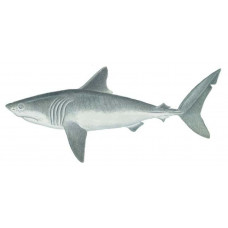Latin name
Lamna nasus
Other names
Beaumaris shark, blue dog, bonito shark, herring shark, mackerel shark, porbeagle, salmon shark.
Identification
The porbeagle has a strong, cobalt blue body with a perfectly conical snout ending in a point. It is easily identified by its teeth, which are smooth and have small fangs on either side of the base. It often has a distinctive white area at the base of the first dorsal fin. This fin is further forward than mako or white sharks. On either side of the caudal fin is a large, particularly prominent flattened keel, and below it, but further back on the tail, a small secondary keel, which mako and white sharks do not have. The anal fin directly adjoins the second dorsal fin.
Distribution
A widespread species, it inhabits the western Atlantic from Newfoundland to New Jersey, although it rarely goes south of New England and probably lives from southern Brazil to Argentina.
Habitat
Excellent sport fish, porbeagles live in colder waters than mako or great white, which may explain why they are not implicated in attacks on humans.
Size
No information
Life history and Behavior
No information
Food and feeding habits
No information
Reproduction
No information
| Classification | |
| Phylum | Chordata |
| Class | Chondrichthyes |
| Squad | Lamniformes |
| Family | Lamnidae |
| Genus | Lamna |
| Species | L. nasus |
| Features | |
| Conservation status | Vulnerable |
| Habitat | Littoral |
| Life span, years | 65 |
| Maximum body weight, kg | 135 |
| Maximum length, cm | 250 |
| Sailing speed, m/s | No information |
| Threat to people | Edible |
| Way of eating | Predator |



